Guides
How to Use an Auger to Unclog a Toilet
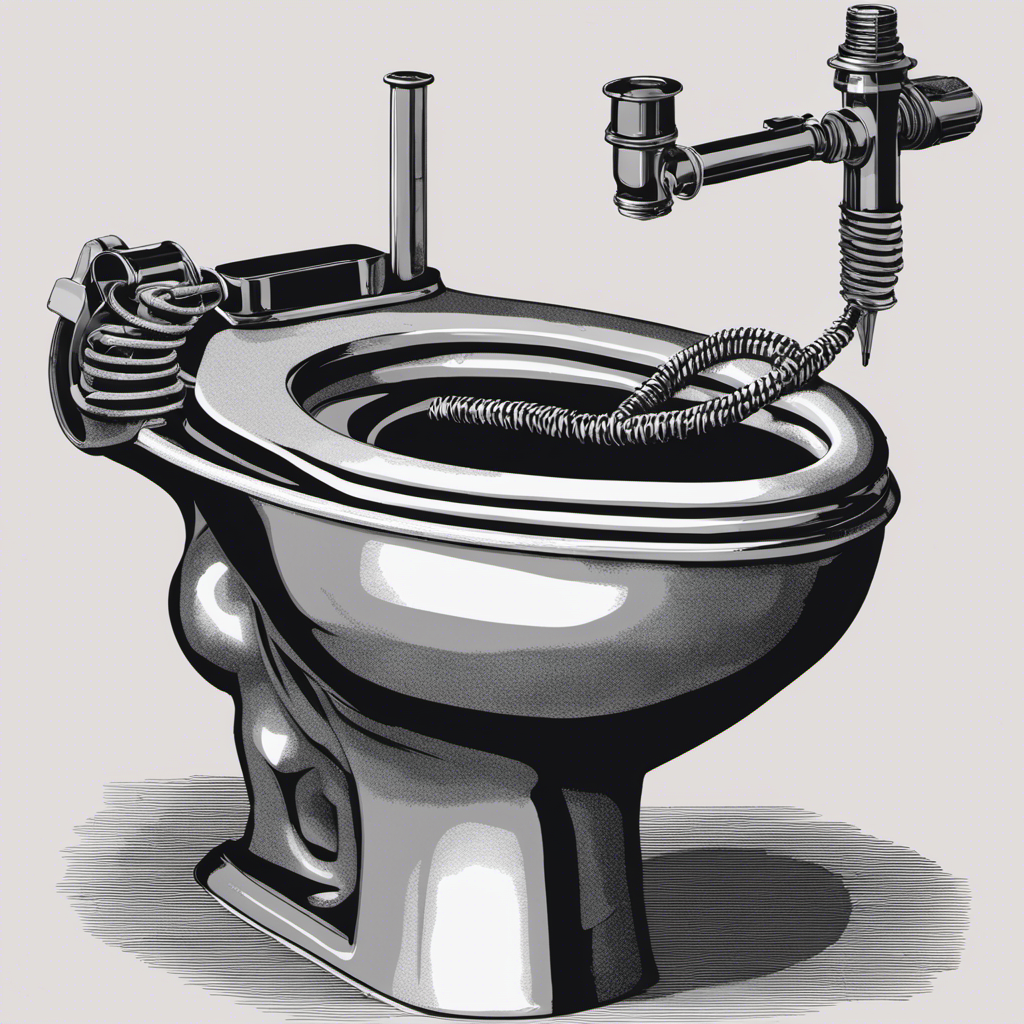
I’ve got a trick up my sleeve that will save you from the dreaded clogged toilet blues. Let me show you how to use an auger to unclog your toilet with ease.
In this informative guide, we’ll dive into the different types of augers and their features. We’ll discuss safety precautions to take before diving in and provide a step-by-step guide to preparing your toilet for auger use.
Get ready to tackle those stubborn clogs head-on and bid farewell to toilet troubles.
Key Takeaways
- Augers are more effective than plungers in clearing stubborn blockages.
- Augers can break up and remove obstructions completely without damaging the toilet.
- Augers are less likely to cause harm compared to chemical cleaners.
- Augers offer increased power and versatility compared to plungers.
Understanding the Auger: Types and Features
To understand the auger better, you’ll need to know the different types and features it comes with.
Augers come in various sizes, ranging from handheld to larger, more powerful models. The size of the auger you choose depends on the severity of the clog and the size of your toilet.
The benefit of using an auger over other unclogging methods is its effectiveness in clearing stubborn blockages. Unlike plungers, which may only push the clog further down the pipes, an auger’s rotating cable can break up and remove the obstruction completely.
Additionally, augers are less likely to damage your toilet compared to harsh chemical cleaners.
Now that you understand the types and benefits of using an auger, let’s discuss the necessary safety precautions before using one.
Safety Precautions Before Using an Auger
Before starting, it’s important to take some safety precautions. Preventing accidents should be our top priority when using an auger to unclog a toilet. Here are three essential safety measures to consider:
-
Wear protective gloves: It’s crucial to protect your hands from any potential harm or bacteria. Rubber gloves are highly recommended to provide a barrier between your skin and any waste materials.
-
Use eye protection: Splashing or spraying can occur during the unclogging process, so wearing safety goggles or glasses is vital to shield your eyes from any debris or chemicals.
-
Keep the area well-ventilated: Ensure there is proper airflow in the bathroom by opening a window or turning on the exhaust fan. This helps prevent the buildup of harmful gases or unpleasant odors.
Taking these safety precautions will help create a safer environment while using an auger. Now, let’s move on to the step-by-step guide to preparing the toilet for auger use.
Step-by-Step Guide to Preparing the Toilet for Auger Use
Now, let’s take a look at how we can get the toilet ready for using the auger.
Before using a toilet auger, it’s important to ensure that the toilet is prepared properly.
Start by putting on a pair of rubber gloves to protect your hands from any potential mess.
Next, remove any excess water from the toilet bowl using a small cup or bucket. This will prevent any splashing when using the auger.
Once the water level is lowered, insert the auger into the toilet drain and slowly rotate the handle in a clockwise motion. This will help to break up any clogs and allow the auger to move freely through the drain.
If necessary, repeat the process until the clog is fully cleared.
Inserting and Maneuvering the Auger in the Toilet Drain
Once you’ve put on your rubber gloves, it’s time to insert and maneuver the auger in the toilet drain. Follow these maneuvering techniques to effectively unclog your toilet:
-
Insert the auger: Carefully lower the auger into the toilet bowl, ensuring that the curved end is facing the drain. Gently push the auger down until you feel resistance.
-
Rotate the handle: With a firm grip on the handle, slowly rotate it in a clockwise motion. This rotation helps to break up the clog and clear the blockage. Be patient and avoid applying excessive force.
-
Adjust the angle: If you encounter a stubborn clog, try adjusting the angle of the auger. Tilt it slightly to the left or right to target different areas of the drain. This can help dislodge the obstruction and restore the flow.
When maneuvering the auger, keep in mind some common obstacles such as tight bends or obstructions in the toilet trap. Gentle, steady movements combined with these techniques can effectively unclog your toilet.
Techniques for Breaking up and Removing the Clog
When it comes to unclogging a toilet, there are two main tools that can be used: an auger and a plunger.
The auger is a flexible cable with a corkscrew-like end that helps break up and remove stubborn clogs, while the plunger uses suction to dislodge the blockage.
To properly use an auger, start by inserting it into the toilet drain and rotating the handle clockwise.
It’s important to take safety precautions while unclogging, such as wearing gloves and eye protection, and being cautious not to damage the toilet bowl or plumbing pipes.
Auger Vs. Plunger
To determine which tool is more effective for unclogging your toilet, you should consider the differences between an auger and a plunger. Here are three reasons why using an auger can be a better option:
-
Increased power: An auger, also known as a plumbing snake, has a long, flexible cable that can reach deep into the pipes to break up stubborn clogs. This extra power allows it to handle tougher obstructions that a plunger may struggle with.
-
Versatility: Unlike a plunger, which is primarily designed for clearing blockages near the toilet bowl, an auger can be used to unclog toilets, sinks, and even bathtub drains. Its versatility makes it a valuable tool to have in your home.
-
Prevents mess: When using a plunger, there is a risk of water splashing out of the toilet bowl, creating a messy situation. On the other hand, an auger allows you to work directly on the clog without the risk of water splashing, keeping your bathroom clean and tidy.
Considering these benefits, it is clear that using an auger can be a more effective and versatile option when dealing with toilet clogs.
Proper Technique for Auger
The proper technique for using an auger involves feeding the cable into the drain and turning the handle clockwise to break up the clog.
To start, insert the auger cable into the toilet bowl and push it in until you feel resistance. Once you encounter the clog, slowly rotate the handle in a clockwise motion. This will help the auger’s cable to grip the blockage and break it apart. Be careful not to apply too much force, as it could damage the plumbing.
As you continue to turn the handle, gradually pull the cable out. This action will bring the clog with it, effectively unclogging the toilet. Remember to clean the auger thoroughly after use to prevent any spread of bacteria.
Now that you know the proper technique, let’s move on to safety precautions while unclogging.
Safety Precautions While Unclogging
One important safety precaution while clearing a blockage is to wear protective gloves to avoid any contact with potentially harmful substances.
When it comes to unclogging a toilet, using a toilet auger is an effective method. However, there are also alternative methods to consider if you don’t have an auger on hand.
Here are three ways to unclog a toilet without an auger:
-
Plunger: A plunger is a common tool used to unclog toilets. It creates suction and pressure to dislodge the blockage.
-
Hot Water and Dish Soap: Pouring hot water mixed with dish soap into the toilet bowl can help break down the clog and allow it to flow through.
-
Baking Soda and Vinegar: Mixing baking soda and vinegar creates a chemical reaction that can help dissolve the blockage. Pour the mixture into the toilet bowl and let it sit for a while before flushing.
While a toilet auger is effective, these alternative methods can be used in a pinch to unclog your toilet.
Troubleshooting Common Issues While Using an Auger
Make sure you’re applying enough pressure while using the auger to avoid any unnecessary clogs or blockages. Troubleshooting techniques are essential to address common issues that may arise while using an auger. Here are some common mistakes and their solutions:
| Problem | Possible Cause | Solution |
|---|---|---|
| Auger not advancing | Insufficient pressure | Apply more downward force |
| Auger getting stuck | Debris or obstruction | Rotate the auger in both directions |
| Auger not reaching clog | Wrong length of auger | Use a longer auger |
Proper Maintenance and Storage of Your Auger
Properly maintaining and storing your auger is essential for ensuring its longevity and optimal performance. Here are some important tips to keep in mind:
-
Regular Cleaning: After each use, make sure to clean the auger thoroughly. Use a cloth or paper towel to remove any debris or residue that may have accumulated. This will prevent any build-up that can affect the auger’s effectiveness.
-
Storage: Find a dry and clean space to store your auger. Avoid exposing it to extreme temperatures or moisture, as this can lead to rust or damage. Hang it on a hook or place it in a sturdy container to prevent any bending or breaking.
-
Troubleshooting: If you encounter any issues while using the auger, such as it getting stuck or not unclogging the toilet properly, refer to the previous subtopic on troubleshooting common issues with toilet clogs. It will provide you with valuable insights and solutions to overcome these challenges.
Conclusion
In conclusion, using an auger to unclog a toilet is a simple yet effective solution. By understanding the different types and features of augers, taking necessary safety precautions, and following a step-by-step guide, you can easily tackle any clog.
Remember to maneuver the auger carefully and use proper techniques to break up and remove the clog. Troubleshooting common issues and maintaining your auger properly will ensure its longevity.
So next time you face a stubborn clog, don’t panic – grab your auger and get to work, because a clear and functional toilet awaits.
With an impeccable eye for detail and a passion for bathroom-related, Ava leads our editorial team gracefully and precisely.
Under her guidance, Best Modern Toilet has flourished as the go-to resource for modern bathroom enthusiasts. In her free time, you might find Ava exploring antique shops and looking for vintage bathroom fixtures to add to her collection.
Guides
Smart Toilets and Aromatherapy: Creating a Spa-Like Bathroom Experience
Imagine transforming your bathroom into a serene spa retreat with smart toilets and soothing aromatherapy—discover how to elevate your daily routine.
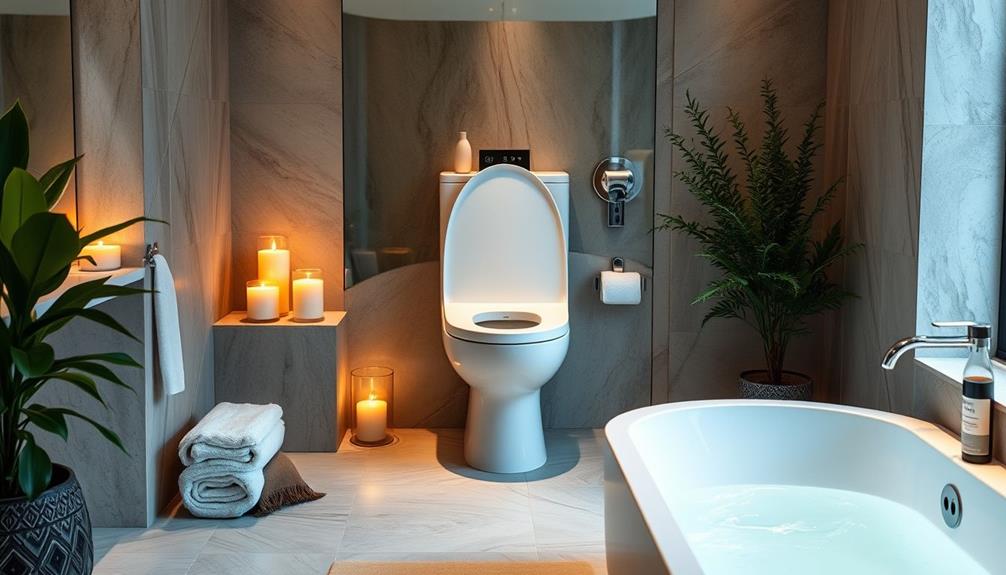
Smart toilets and aromatherapy can truly elevate your bathroom into a spa-like oasis. With features like touchless functions and built-in bidets, smart toilets enhance hygiene and comfort, making every visit feel luxurious. Pair this with calming essential oils from a diffuser, and you create a soothing atmosphere that promotes relaxation and reduces stress. You can enhance your space further with warm lighting, natural materials, and high-quality oils to amplify the therapeutic effects. Combining these elements not only transforms your daily routine but also supports your overall wellness. Explore how to create this blissful retreat right in your own home.
Key Takeaways
- Smart toilets enhance hygiene with touchless functions and self-cleaning capabilities, creating a luxurious bathroom experience.
- Integrating essential oil diffusers fills the space with calming scents, promoting relaxation and wellness.
- Voice-activated technology allows for personalized control over lighting and music, enhancing the spa-like atmosphere.
- Freestanding bathtubs and rainfall showerheads add a touch of elegance, creating a serene environment for unwinding.
- Combining advanced hygiene technology with soothing aromatherapy supports overall mental health and comfort in the bathroom.
Benefits of Smart Toilets
Smart toilets are revolutionizing bathroom experiences with their innovative features designed for hygiene and comfort. These advanced fixtures elevate your spa-like bathroom by incorporating touchless features, such as automatic lid opening and flushing, which minimize germ exposure and promote cleanliness.
With smart toilets, you can enjoy enhanced hygiene without the hassle of harsh chemical cleaners, thanks to self-cleaning capabilities that utilize UV light or electrolyzed water. Regular inspection of components, such as the fill valve, can also contribute to maintaining peak performance and efficiency, as seen in toilet maintenance practices.
Additionally, many models boast built-in bidet functions, allowing you to adjust water pressure and temperature for a personalized cleansing experience. This level of comfort is especially appreciated during colder months, as heated seats provide a luxurious touch.
Smart toilets also integrate seamlessly with your smart home technology, giving you the power of voice control or smartphone apps to customize settings to fit your preferences. Whether you want to adjust the water temperature or activate cleaning modes, these personal touches allow you to create a truly tailored bathroom experience.
In a world where comfort and hygiene are paramount, smart toilets redefine what it means to have a luxury bathroom, making everyday routines feel like a pampering retreat.
The Power of Aromatherapy

Aromatherapy can transform your bathroom into a tranquil retreat that soothes the mind and body. By incorporating essential oils, you create a spa-like atmosphere that enhances your overall wellness. The calming properties of certain scents can promote relaxation and reduce stress, making your bathing rituals even more enjoyable.
Additionally, using high-quality essential oils guarantees that you experience their full therapeutic benefits, as purity is critical for effectiveness quality and purity are critical.
Imagine stepping into your bathroom and being enveloped by:
- The soothing scent of lavender, easing your mind and inviting tranquility.
- The invigorating aroma of eucalyptus, revitalizing your spirit and lifting your mood.
- A warm bath infused with essential oils, amplifying the therapeutic effects as the heat disperses the fragrance.
- Soft, ambient lighting that complements the sensory experience, encouraging deep inhalation and absorption.
Studies show that specific aromas can greatly influence mood and cognitive function, making aromatherapy an effective tool for enhancing mental health.
By blending warm baths or steam showers with essential oils, you maximize their therapeutic benefits. This powerful combination invites relaxation, rejuvenation, and a deeper connection to yourself, allowing you to unwind fully.
Embrace the power of aromatherapy, and turn your bathroom into a sanctuary of serenity.
Designing Your Spa Retreat
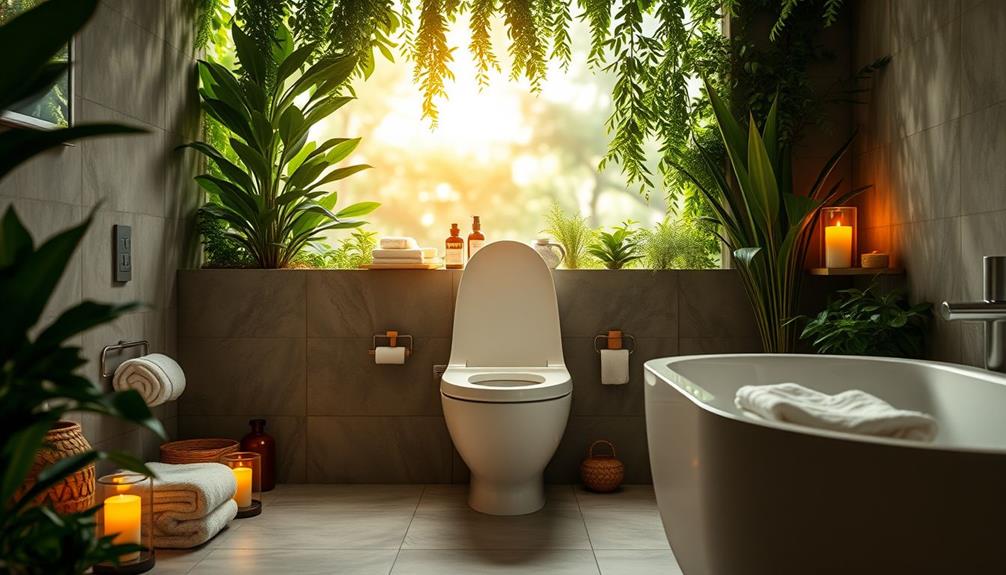
When it comes to designing your spa retreat, you'll want to focus on creating a harmonious environment that promotes relaxation and rejuvenation. Start by incorporating smart technology, such as smart toilets with bidet features, which enhance hygiene and elevate the luxury experience in your spa-inspired bathroom.
Utilize essential oil diffusers to transform the atmosphere, filling the space with calming scents that enrich your bathing experience. Consider adding candles to the mix; they can create a warm ambiance and provide soothing fragrances when made from natural materials like soy or beeswax, ensuring a healthier indoor air quality candle safety precautions.
Choose design elements like a freestanding bathtub and a rainfall showerhead to create stunning focal points that embody the essence of a spa experience at home. Opt for a cohesive color palette featuring soft neutrals and soothing colors, fostering a serene environment that contributes to an overall sense of tranquility.
Integrate natural materials like bamboo and stone throughout your design to enhance your connection to nature, amplifying the spa-like ambiance.
Don't forget to add plush towels for that extra touch of comfort and luxury. By thoughtfully combining these elements, you're not only designing a bathroom but also curating a personal oasis that invites relaxation and revitalization, allowing you to escape the stresses of everyday life.
Integrating Technology in Bathrooms
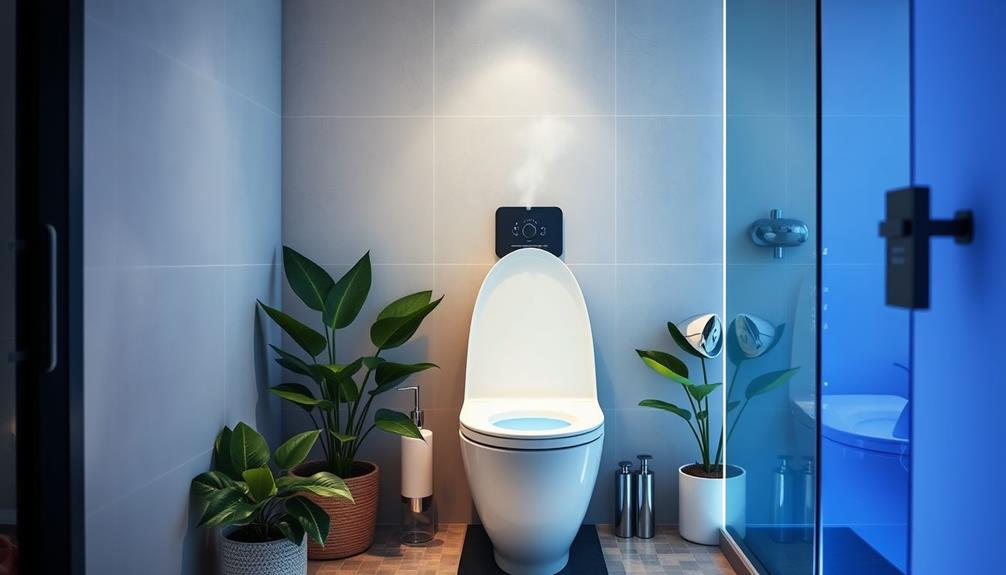
Creating a spa-like atmosphere in your bathroom can be greatly enhanced by integrating technology that caters to your comfort and convenience.
Imagine stepping into a space where every detail is designed for your relaxation and enjoyment. With smart toilets featuring built-in bidet functions, heated seats, and automatic lid and flush controls, your hygiene and comfort will reach new heights.
To further elevate your experience, consider incorporating essential oils that can promote relaxation and well-being, such as essential oils for relaxation.
Consider these features for your spa-inspired bathroom:
- Voice-activated systems for controlling lighting, water temperature, and soothing music
- Digital faucets allowing precise temperature control for an ideal shower experience
- Smart mirrors with LED displays providing weather updates and news
- Automated air fresheners and essential oil diffusers that release calming scents like lavender
Enhancing Comfort and Wellness
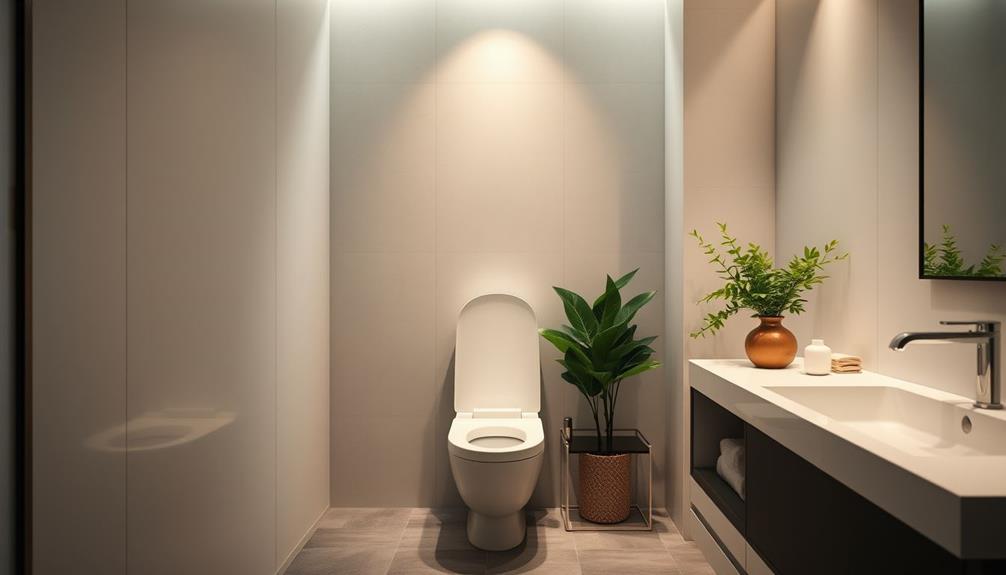
How can you transform your bathroom into a sanctuary of comfort and wellness? By integrating smart toilets and aromatherapy, you can create a spa-like feel that promotes relaxation and enhances your overall well-being.
Imagine stepping into a bathroom where a heated seat welcomes you, along with touchless technology that elevates hygiene and comfort. Smart toilets not only offer luxurious features but also encourage personal hygiene, making your bathroom experience feel more indulgent.
Additionally, maintaining a clean indoor environment through the use of air purifiers can further enhance your wellness experience, as they help eliminate allergens and improve air quality.
To further enhance this sensory experience, consider incorporating essential oil diffusers. Scents like lavender and eucalyptus can fill the air, promoting relaxation and reducing stress.
The combination of these calming aromas with the advanced technology of smart toilets creates an environment that supports mental health and wellness.
Frequently Asked Questions
How to Make Your Bathroom Feel Like a Spa?
To make your bathroom feel like a spa, focus on calming colors, soft lighting, and soothing scents. Add plush towels, a rainfall showerhead, and relaxing music to create an inviting, tranquil atmosphere you'll love.
How to Make a Bathroom Smell Like a Spa?
Imagine stepping into a serene oasis. You can light aromatherapy candles, diffuse calming essential oils, and place fragrant plants around. These simple touches create a soothing ambiance, making your bathroom feel like a luxurious spa retreat.
How to Make Your Bathroom a Smart Bathroom?
To make your bathroom smart, install bidet toilets, digital faucets, and smart mirrors. Add voice-activated lighting and customizable shower systems. These upgrades enhance convenience, efficiency, and comfort, transforming your space into a modern oasis.
What Does Spa Like Bathroom Mean?
Imagine stepping into a bathroom that feels like a five-star resort! A spa-like bathroom means luxurious features, calming colors, and soothing scents, all designed to whisk you away into pure relaxation and bliss after a long day.
Conclusion
Incorporating smart toilets and aromatherapy into your bathroom transforms it into a personal oasis. As the saying goes, "home is where the heart is," and creating this spa-like retreat enhances your comfort and wellness. By embracing the latest technology and soothing scents, you can elevate your daily routine into a rejuvenating experience. So go ahead, indulge yourself—you deserve a little luxury in your life!
With an impeccable eye for detail and a passion for bathroom-related, Ava leads our editorial team gracefully and precisely.
Under her guidance, Best Modern Toilet has flourished as the go-to resource for modern bathroom enthusiasts. In her free time, you might find Ava exploring antique shops and looking for vintage bathroom fixtures to add to her collection.
Guides
Eco-Friendly Materials in Smart Toilet Manufacturing
Amid growing environmental concerns, discover how eco-friendly materials in smart toilet manufacturing can transform your bathroom and benefit the planet.

Eco-friendly materials are essential in crafting smart toilets, considerably reducing environmental impact. You'll find recycled porcelain and bamboo as primary choices, both minimizing reliance on virgin resources. Stainless steel adds durability and recyclability, ensuring a longer lifespan. Additionally, biodegradable plastics, derived from plants like cornstarch, lessen landfill waste and reduce carbon footprints. These materials don't just conserve resources; they also promote better hygiene and enhance indoor air quality. By embracing these sustainable options, you'll contribute to a healthier planet, making your bathroom eco-friendlier than ever. Learn how these innovations are shaping the future of smart toilets.
Key Takeaways
- Eco-friendly materials like recycled porcelain and bamboo reduce environmental impact and support a circular economy in smart toilet manufacturing.
- Stainless steel offers durability and recyclability, promoting sustainability and lowering overall carbon footprints.
- Biodegradable plastics made from plant-based materials significantly reduce landfill contributions and greenhouse gas emissions during production.
- Low-flow technology and dual-flush systems in smart toilets enhance water conservation, saving thousands of gallons annually.
- Antimicrobial materials improve hygiene and indoor air quality, contributing to healthier living environments in eco-friendly toilet designs.
Importance of Eco-Friendly Materials
In today's world, the importance of eco-friendly materials in smart toilets can't be overstated. By opting for sustainable materials, you help reduce the environmental footprint associated with traditional toilet manufacturing. Eco-friendly materials like recycled porcelain and bamboo minimize the need for virgin resources and energy-intensive processes, making your choice a responsible one.
Additionally, many health-focused lifestyle blogs highlight the benefits of using eco-friendly products in daily life, encouraging consumers to make informed choices that align with their values, such as diverse content on nutrition.
Choosing a sustainable toilet made from stainless steel not only enhances durability but also guarantees recyclability at the end of its life cycle, promoting a circular economy. High-quality plastic alternatives made from plant-based materials, such as cornstarch, are biodegradable. This means they contribute less to landfills, making them appealing to eco-conscious consumers.
Moreover, incorporating these eco-friendly materials into smart toilet designs supports significant water conservation efforts. Many of these materials work in tandem with water-efficient technologies, helping to reduce overall water usage.
As consumer demand for environmentally responsible products rises, manufacturers that prioritize eco-friendly materials can enhance their brand reputation and foster customer loyalty. Embracing these materials isn't just a trend; it's a step towards a more sustainable future for all.
Types of Sustainable Materials

When it comes to choosing sustainable materials for smart toilets, several options stand out for their eco-friendliness and functionality. One popular choice is recycled porcelain, which not only reduces waste but also contributes to the circular economy by using reclaimed materials. This helps lower the carbon footprint associated with new production processes.
Additionally, incorporating materials that are both functional and sustainable, like butter's nutritional benefits, can inspire innovative designs that prioritize health and environmental consciousness.
Another excellent option is bamboo toilet seats. Bamboo is a highly renewable resource, known for its durability and moisture resistance, making it an ideal material for bathroom fixtures. Plus, its sustainable harvesting practices make it an environmentally friendly choice.
Stainless steel is also favored in smart toilet manufacturing. Its long-lasting and corrosion-resistant properties guarantee that it remains functional for years and is fully recyclable at the end of its lifespan.
Additionally, some smart toilets feature biodegradable materials, such as high-quality plastics derived from cornstarch. These materials promote sustainable solutions while minimizing environmental impact.
Lastly, incorporating antimicrobial materials enhances hygiene by inhibiting bacterial growth, improving indoor air quality, and guaranteeing a healthier bathroom environment.
Benefits of Recycled Porcelain
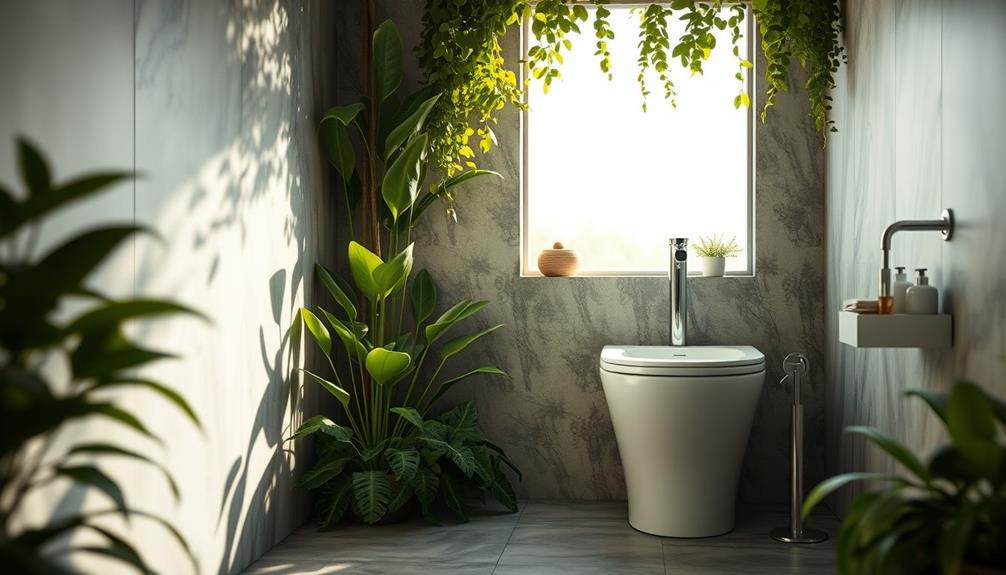
Recycled porcelain stands out as a top choice in the domain of eco-friendly materials for smart toilets due to its impressive environmental benefits. By utilizing reclaimed materials, recycled porcelain helps reduce waste and supports a circular economy in smart toilet manufacturing. This means that less material ends up in landfills, making it an environmentally friendly option.
Additionally, incorporating recycled materials can enhance a company's portfolio diversification by aligning with sustainable practices.
Moreover, using recycled porcelain considerably lowers the carbon footprint associated with production. It requires less energy and fewer virgin materials compared to traditional porcelain, which is essential in today's sustainability-focused market.
The durability of recycled porcelain also guarantees that your smart toilet maintains high performance and aesthetic appeal over time, reducing the need for frequent replacements.
Incorporating recycled porcelain allows manufacturers to meet sustainability certifications, enhancing their market competitiveness. This appeals to eco-conscious consumers who prioritize sustainable materials in their purchasing decisions.
Additionally, the use of recycled porcelain minimizes the extraction of natural resources, promoting responsible sourcing practices.
Advantages of Bamboo Seats

Bamboo seats offer a remarkable eco-friendly alternative to traditional toilet seat materials. When you choose a bamboo seat, you're opting for a sustainable resource that grows quickly and can be harvested without harming the plant. This means that the environmental impact is considerably lower than that of seats made from non-renewable materials.
Additionally, adopting eco-friendly materials can also contribute to overall wellness, similar to how a holistic lifestyle approach enhances well-being in various aspects of health.
Moreover, bamboo is naturally resistant to moisture and mold, which makes these seats durable and long-lasting compared to conventional plastic or wood options. You'll appreciate how they stand up to daily use while maintaining their aesthetic appeal.
With their stylish, natural look, bamboo seats can easily complement various bathroom designs, adding a touch of elegance while being eco-conscious.
Additionally, the production of bamboo toilet seats generally has a lower carbon footprint, supporting a circular economy that prioritizes sustainability. By utilizing bamboo, you also help reduce waste and promote responsible harvesting practices.
Plus, bamboo's efficient growth means it requires less water usage compared to traditional hardwoods, making it a smarter choice for both your home and the planet.
Embracing bamboo seats not only enhances your bathroom but also aligns with your eco-friendly values.
Stainless Steel and Its Impact
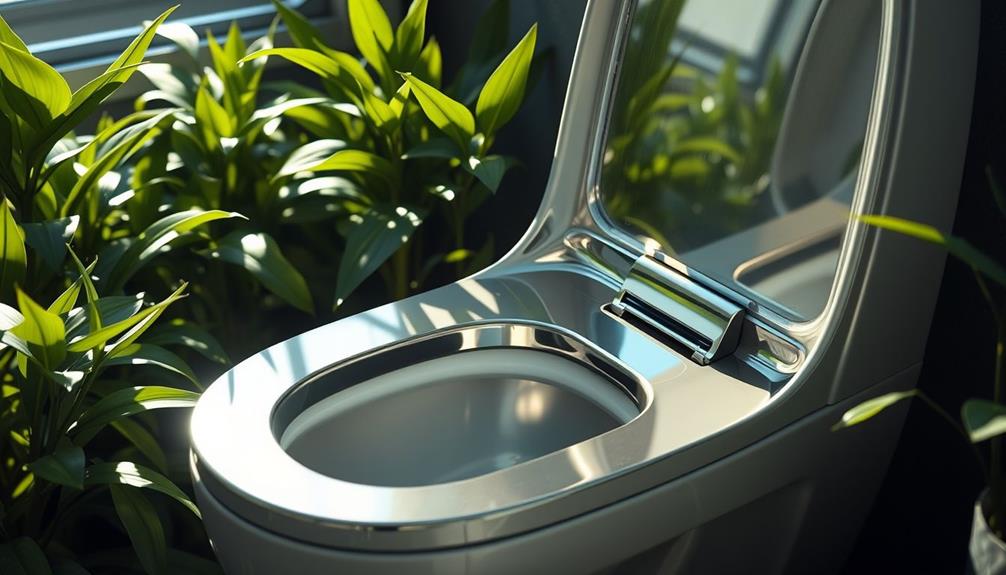
Stainless steel toilets are a game-changer for eco-conscious homeowners seeking durability and style.
These toilets boast a remarkable lifespan, thanks to their high corrosion resistance, which means you won't have to worry about frequent replacements.
When you choose stainless steel, you're also making a significant contribution to reducing the environmental impact of toilet manufacturing.
Additionally, proper toilet maintenance, such as regular inspections and cleaning, can further enhance the longevity of these eco-friendly fixtures, leading to a more sustainable bathroom environment.
Regular cleaning prevents buildup and clogs, ensuring peak performance over time.
Here's why stainless steel is the smart choice for your bathroom:
- High recycled content: This material requires less energy to produce, lowering its carbon footprint.
- Fully recyclable: At the end of their life cycle, stainless steel toilets can be completely recycled, promoting a circular economy.
- Antimicrobial properties: These toilets help inhibit bacterial growth, enhancing hygiene in your bathroom.
- Sleek aesthetic: Stainless steel adds a modern touch to your bathroom design, elevating its overall look.
- Sustainable alternative: Compared to traditional materials, stainless steel provides a robust and eco-friendly option.
Innovations in Plastic Alternatives

You might be surprised to learn about the advancements in biodegradable plastics, especially those made from plant-based materials like cornstarch.
These innovations not only cut down on landfill waste but also offer a more sustainable alternative for smart toilets.
Additionally, the use of vegan alternatives in materials emphasizes a commitment to environmentally friendly practices.
As you consider your options, think about how these eco-friendly materials can enhance both functionality and environmental responsibility.
Biodegradable Plastic Innovations
Driving innovation in sustainable design, biodegradable plastics are transforming the landscape of smart toilets. Made from plant-based materials like cornstarch, these biodegradable alternatives break down naturally within months to years, greatly reducing long-term environmental impact compared to traditional petroleum-based plastics.
This change not only minimizes landfill contributions but also promotes a circular economy. Additionally, the push for eco-friendly manufacturing processes parallels the growing interest in renewable energy sources, such as geothermal energy, which further emphasizes sustainability in modern construction practices.
Recent advances in biodegradable plastic formulations have improved their durability and moisture resistance, making them ideal for smart toilet manufacturing without sacrificing functionality. You can feel good knowing that these eco-friendly toilets utilize materials that lower carbon footprints by up to 30% compared to conventional plastic production processes.
Here are some key benefits of biodegradable plastics in smart toilets:
- Break down naturally, reducing landfill waste.
- Lower long-term environmental impact.
- Improved durability for practical use.
- Appeal to eco-conscious consumers seeking sustainable options.
- Support a circular economy by promoting recycling and reuse.
Plant-Based Material Benefits
Building on the advancements in biodegradable plastics, plant-based materials are gaining traction as innovative alternatives in smart toilet manufacturing. Derived from sources like cornstarch, these materials are biodegradable and can greatly reduce contributions to landfills compared to traditional petroleum-based plastics. They decompose in industrial composting facilities within 90 to 180 days, promoting a circular economy and minimizing environmental impact.
| Benefit | Description |
|---|---|
| Biodegradable | Decomposes in composting facilities within 90-180 days. |
| Reduced Greenhouse Gas Emissions | Emits up to 70% less greenhouse gas during production. |
| Comparable Durability | Matches the durability and functionality of traditional materials. |
| Appeals to Eco-Conscious Buyers | Aligns with consumer demand for sustainable products. |
Water Conservation Strategies

When you adopt low-flow technology in your bathroom, you're not just saving water; you could cut your usage by up to 60%.
Dual-flush systems let you choose the right flush for the job, helping you save even more.
Plus, consider waterless urinals, which can conserve a staggering amount of water each year while reducing your environmental footprint.
Low-Flow Technology Adoption
Low-flow technology is revolutionizing water conservation strategies in modern bathrooms. By adopting low-flow toilets, you can reduce water consumption to 1.28 gallons per flush or less, which cuts your water use by at least 50% compared to traditional models.
This not only helps you conserve water but also contributes to a more sustainable bathroom environment. Additionally, implementing eco-friendly materials in your bathroom fixtures can further enhance sustainability efforts.
Consider these benefits of low-flow technology:
- Save approximately 13,000 gallons of water annually.
- Potentially cut over $140 from your water bills each year.
- Use water-efficient fixtures that meet EPA WaterSense standards.
- Enjoy improved energy efficiency while maintaining performance.
- Reduce your household carbon footprint.
Dual-Flush System Benefits
Integrating a dual-flush system into your bathroom can amplify the water-saving benefits of low-flow technology. With dual-flush toilets, you get two flush options: a lower volume flush for liquid waste (typically 0.8 gallons) and a full flush for solid waste (typically 1.6 gallons). This design effectively helps you reduce water consumption while maintaining performance.
By implementing strategies to optimize your water usage, you can enhance your eco-friendly initiatives and improve overall household efficiency, aligning with keyword optimization and content strategy.
By switching to dual-flush toilets, you can lower your household's toilet water usage by about 20-60%. For an average family of four, this translates to saving between 15,000 to 20,000 gallons of water each year. Not only does this lead to reduced water bills, but it also greatly lessens your environmental impact.
Moreover, using a dual-flush system encourages mindful water usage, allowing you to choose the appropriate flush based on waste type. This promotes conservation habits that align perfectly with an eco-friendly bathroom ethos.
Many modern dual-flush models even enhance your bathroom's aesthetics, proving that you don't have to sacrifice style for sustainability. Overall, adopting this technology lets you save money while making a positive difference for the planet.
Waterless Urinal Efficiency
Waterless urinals consistently prove to be an efficient solution for water conservation in both commercial and residential settings. By using these innovative fixtures, you can save at least 56,800 liters of water annually per unit, markedly reducing overall water consumption.
Unlike traditional urinals, waterless models utilize a biodegradable sealant that traps odors without requiring any flushing water. This makes them an environmentally friendly choice, especially beneficial in regions where water is scarce. Additionally, adopting such sustainable fixtures can support broader environmental goals, as seen in initiatives promoting efficient water use.
By installing waterless urinals, you not only adopt sustainable bathroom practices but also enjoy considerable savings on your water bills. They align perfectly with broader water conservation strategies, such as the EPA's WaterSense program, promoting efficient water use.
Here are some key benefits of waterless urinals:
- Marked water savings of up to 56,800 liters annually
- No need for flushing, reducing water consumption
- Biodegradable sealant eliminates odors effectively
- Cost-effective solution for both businesses and homeowners
- Supports environmentally friendly practices in your bathroom
Switching to waterless urinals is a smart move for anyone looking to make a positive impact on our environment while saving money.
Health and Environmental Considerations

When considering health and environmental impacts, eco-friendly materials in smart toilets play a crucial role. By using recycled porcelain and bamboo, manufacturers not only cut down on carbon footprints but also enhance indoor air quality, minimizing harmful substances during production. This choice leads to healthier living spaces for you and your family.
Stainless steel is another excellent material, offering durability and corrosion resistance while being fully recyclable, thereby supporting a circular economy.
Additionally, high-quality plastic alternatives made from plant-based materials biodegrade, helping reduce landfill waste and your exposure to harmful chemicals from traditional plastics.
Moreover, incorporating antimicrobial properties into these materials effectively inhibits bacterial growth, promoting better hygiene and health in your bathroom environment.
A lifecycle assessment of these eco-friendly materials shows a significant reduction in resource depletion and environmental impact, aligning with sustainable development goals.
This commitment to sustainability not only benefits your health but also guarantees a cleaner planet for future generations.
Future Trends in Smart Toilets

As smart toilets evolve, you'll notice an impressive shift towards sustainability and user-centric design. Future trends in smart toilets are set to revolutionize your bathroom experience while promoting eco-friendly practices.
Manufacturers are increasingly using sustainable materials like recycled porcelain and bamboo, greatly reducing environmental impact.
You can expect advanced water-saving technologies that save households around 13,000 gallons of water annually, making a notable contribution to water conservation efforts. Plus, future smart toilets will offer enhanced customization options, allowing you to adjust water temperature and pressure to suit your preferences.
Here are some exciting trends to look out for:
- Sensors that optimize water usage based on individual needs.
- Integration of smart technology that enhances performance without sacrificing eco-friendliness.
- User-friendly interfaces for easier control and customization.
- Expanded use of sustainable materials in manufacturing processes.
- Increased market growth, projected at a CAGR of 10.5% from 2020 to 2027.
These innovations not only make your bathroom smarter but also align with your values for sustainability and resource efficiency.
Frequently Asked Questions
Are Smart Toilets Eco-Friendly?
Yes, smart toilets are eco-friendly. They feature water-efficient technologies and advanced flushing systems that greatly reduce water usage. Plus, many models incorporate energy-saving features, promoting a sustainable bathroom experience while enhancing your comfort.
What Is Eco-Friendly Toilet Paper Made Of?
Eco-friendly toilet paper's made from recycled paper, bamboo, or agricultural residues like wheat straw. These materials reduce deforestation and waste, while biodegradable processes guarantee no harmful chemicals pollute the environment during production.
Is There an Eco-Friendly Alternative to Toilet Paper?
Yes, there are eco-friendly alternatives to toilet paper. You can use bidets, reusable cloth wipes, or bamboo toilet paper. These options reduce waste, save trees, and offer sustainable solutions for your bathroom needs.
How Are Toilets Eco-Friendly?
Toilets are eco-friendly because they use water-efficient fixtures, like low-flow systems, reducing water waste. Many also incorporate sustainable designs and materials, promoting better hygiene while minimizing environmental impact through innovative waste management solutions.
Conclusion
Incorporating eco-friendly materials in smart toilet manufacturing isn't just a trend; it's a necessity. Did you know that using recycled porcelain can reduce energy consumption by up to 30%? By choosing sustainable options like bamboo seats and stainless steel, you're not only enhancing your bathroom's efficiency but also contributing to a healthier planet. As innovations continue to emerge, the future of smart toilets looks promising, blending technology with environmental responsibility. Let's embrace these changes for a greener tomorrow!
With an impeccable eye for detail and a passion for bathroom-related, Ava leads our editorial team gracefully and precisely.
Under her guidance, Best Modern Toilet has flourished as the go-to resource for modern bathroom enthusiasts. In her free time, you might find Ava exploring antique shops and looking for vintage bathroom fixtures to add to her collection.
Guides
The Debate Over Smart Toilet Data Collection: Privacy Vs. Health Benefits
Learn how smart toilets weigh the benefits of health monitoring against the potential risks of privacy invasion, raising critical questions about our digital future.
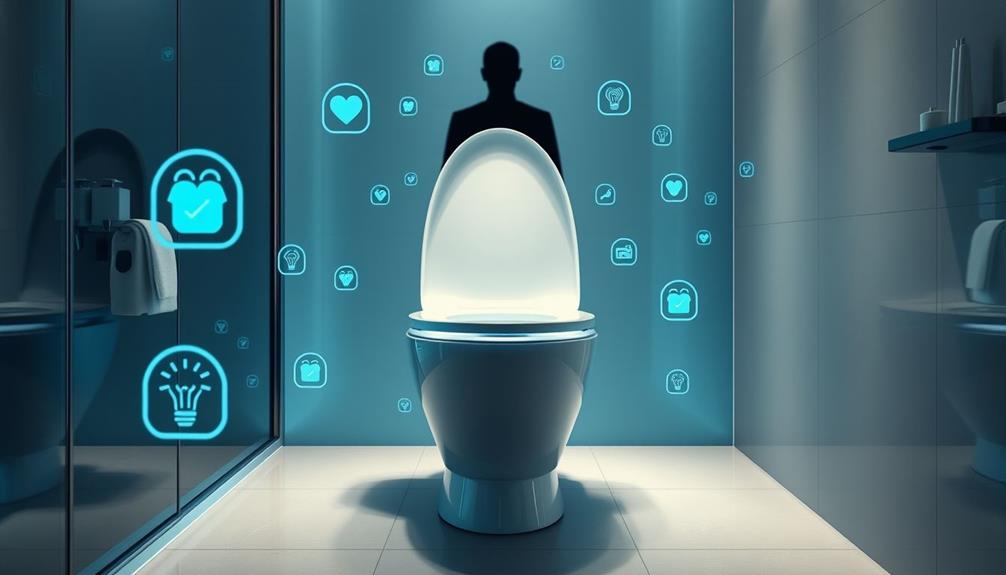
Smart toilets offer a blend of health benefits and privacy concerns. By collecting detailed health data, these devices can detect over 600 health conditions, promoting proactive health management. However, the collection of sensitive information raises serious privacy risks. Hacking could expose personal data, and current security measures often fall short. Users might hesitate to share their data due to concerns about misuse and consent. Balancing these factors is essential for acceptance. So, if you want to explore how smart toilets navigate these complex issues, there's more to uncover about the ongoing discussions in this evolving field.
Key Takeaways
- Smart toilets offer significant health benefits by detecting over 600 conditions, promoting proactive health management and timely interventions.
- Privacy concerns arise from sensitive data collection, with risks of hacking and inadequate consent mechanisms potentially compromising user information.
- Existing privacy laws may not adequately protect user data or keep pace with technological advancements, raising ethical issues surrounding data sharing.
- User willingness to share data increases with clear communication about health benefits and robust privacy protections, fostering trust in the technology.
- Effective integration into daily routines relies on user comfort and control over personal data, balancing convenience with privacy concerns.
Smart Toilet Technology Overview
Smart toilets represent a groundbreaking advancement in health technology, merging everyday bathroom fixtures with sophisticated sensor systems. These smart toilets are equipped with advanced sensor technologies that analyze waste data, providing you with vital health insights. By monitoring aspects like urine flow and waste texture, they can help detect diseases such as cancer and infections, allowing for early intervention.
Additionally, understanding toilet mechanics and the importance of proper waste disposal can contribute to overall health, making smart toilets an even more valuable addition to modern bathrooms, especially as toilet types and efficiency continue to evolve.
Using biomarker technology, smart toilets can also track various health indicators. They can identify the presence of blood in urine and gather metabolic health information tied to your nutrition and lifestyle. Research at Stanford Medicine has propelled this technology, aiming to enhance early disease detection through real-time monitoring.
Moreover, smart toilets connect to secure cloud storage, enabling the safe transmission of health data. This capability raises important discussions around data privacy and user consent, ensuring that your health information remains protected.
The potential integration of smart toilet technology into public health applications could facilitate large-scale health monitoring, tracking infectious disease outbreaks, and improving urban living through smart city initiatives. As you consider the benefits, it's important to weigh the implications of this innovative technology on your health and privacy.
Health Benefits of Data Collection
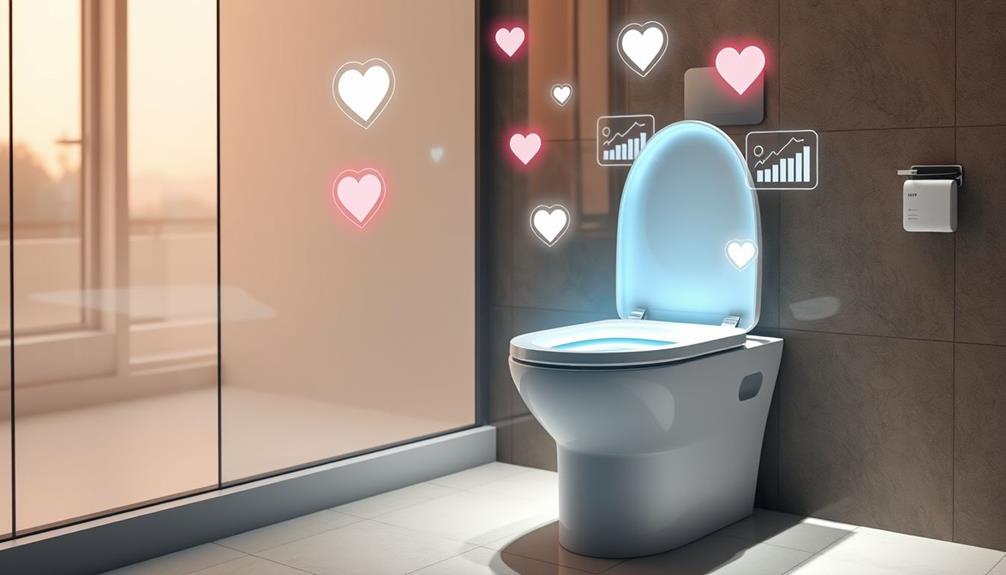
By leveraging advanced data collection capabilities, smart toilets offer significant health benefits that can transform how you monitor your well-being. These innovative devices can analyze urine to detect over 600 human conditions, including serious illnesses like cancer and diabetes, by monitoring metabolites linked to your health and lifestyle.
Regular use of smart toilets can lead to improved awareness about health indicators, promoting proactive health management and encouraging healthier lifestyle choices. Additionally, incorporating insights from the importance and benefits of play can help foster overall well-being in children and adults alike.
Frequent urine monitoring through smart toilets provides real-time health insights, allowing you to make timely interventions based on your individual health data. Imagine having access to non-invasive testing for various biomarkers through the integration of smart toilets with portable mass spectrometry technology. This could enhance the accessibility of health monitoring in your everyday life.
Moreover, smart toilet data collection can improve public health outcomes by identifying trends in disease outbreaks, such as COVID-19, through large-scale, anonymized data analysis. For the aging population, utilizing smart toilets for health monitoring may also enhance medication adherence tracking, providing insights into drug metabolism and overall health management.
With these benefits, smart toilets can empower you to take control of your health and foster a proactive approach to well-being.
Privacy Concerns and Risks

As you consider using a smart toilet, think about the sensitive health data it collects and the potential privacy risks involved.
These devices can be vulnerable to hacking, which might expose your personal information to unauthorized users.
Furthermore, similar to how emails remain vulnerable to hacking, smart toilets may not have robust security measures in place.
Additionally, the current consent mechanisms may not protect you adequately, raising concerns about how your data could be shared or misused.
Data Collection Concerns
Concerns about data collection in smart toilets revolve around the sensitive health information they gather, such as urine and waste analysis. You might worry about how this data could be misused or exposed. With personal health data being collected, privacy concerns escalate, especially considering the potential for unauthorized access.
| Concern | Description | Implication |
|---|---|---|
| Sensitive Data | Smart toilet seats collect detailed health metrics. | Increased risk of privacy breaches. |
| Data Security Measures | Without proper security, hackers can access your data. | Potential exposure of personal info. |
| Consent Mechanisms | Ethical debates on consent types can affect privacy. | User autonomy may be compromised. |
| Legal Protections | Privacy laws exist but may not keep up with technology. | Questions about effectiveness remain. |
It's essential to understand that the information gathered is subject to privacy standards similar to those for healthcare providers. However, the effectiveness of these safeguards in an evolving tech landscape raises significant questions. As you consider smart toilet technology, weigh the health benefits against these data collection concerns to make an informed decision.
Security Vulnerabilities Analysis
Smart toilets, while innovative, come with serious security vulnerabilities that can compromise your privacy. These devices collect sensitive health data, including biomarker information, which can be a treasure trove for hackers if not properly secured.
Security experts warn that unauthorized access to smart toilet systems could expose your personal health information, akin to breaches seen in traditional healthcare environments. Additionally, the collection of health data by smart devices raises concerns about diversification of retirement portfolio and how it parallels safeguarding our personal information, emphasizing the need for robust security measures.
Data gathered by these toilets is subject to the same privacy standards as that from healthcare providers, making stringent data protection measures essential. The ongoing debate about consent mechanisms is critical; you should understand whether you're giving blanket or active consent for your information to be collected. Without clear guidelines, your privacy could be at risk.
Moreover, the ethical implications of health data misuse are concerning. There's potential for law enforcement to access this information, raising alarms about the erosion of your privacy rights.
As smart toilets become more common, it's crucial to scrutinize how data is collected, stored, and shared. Ensuring your privacy is protected should be a priority as you consider the benefits these devices offer.
User Experience Insights

As you explore the user experience of smart toilets, you'll notice that installation can be straightforward but may come with some design challenges.
The data collected by smart toilets can enhance personalized experiences, yet many users are also hesitant about sharing their data, which influences how they integrate this technology into their daily routines.
Balancing convenience and privacy will be key to enhancing your overall experience with smart toilet technology, especially considering the ethical considerations in educational data mining.
Installation Experiences and Challenges
Many users found the installation of smart toilet seats to be relatively straightforward, yet several encountered challenges that stemmed from design flaws and compatibility issues with their existing hygiene practices.
While the initial setup might seem easy, you may face complications during the dismantling process of your old toilet seat, which can disrupt your overall experience. Additionally, having the right tools and essential items for a home cleaning kit can greatly facilitate the cleaning and maintenance of your new smart toilet setup.
Clear installation instructions and support are essential to address these user concerns effectively. Without them, you might feel frustrated, especially if you run into unexpected issues that hinder your convenience.
The shift to a smart bathroom can be exciting, but your comfort level with integrating the smart toilet into your daily routine plays a significant role in how satisfied you're with the experience.
Some participants reported feeling hesitant about adopting this new technology, which could impact their long-term use of smart toilets.
To enhance user acceptance and satisfaction, manufacturers need to focus on improving installation processes and ensuring compatibility with various bathroom setups. By addressing these challenges, you're more likely to enjoy the benefits of smart toilet technology in your home.
Data Sharing Willingness
Data sharing willingness among users of smart toilets reveals a complex landscape of preferences and concerns. You might find that your comfort level hinges on several key factors. Many users express a strong desire for ownership and control over their personal data, which is often a deal-breaker when it comes to sharing.
For instance, similar to users of air purifiers, concerns about health benefits and privacy frequently intersect. Here are three emotional drivers that shape your willingness to share:
- Health Benefits: If sharing your usage data could lead to improved health insights, you might be more inclined to consent.
- Privacy Protection: You likely want assurances that your sensitive information is secure and confidential, which can greatly affect your trust.
- Control Options: Knowing you can opt-out or manage your data preferences gives you a sense of empowerment, making you more open to sharing.
Clear communication about the purpose of data collection also plays a vital role. When you're informed about how your data will be used and the specific benefits it may bring, your data sharing willingness increases.
Ultimately, balancing health benefits with privacy concerns is key to steering through this new technology.
Integration Into Daily Routines
Integrating a smart toilet seat into your daily routine can greatly enhance your hygiene practices, but its success hinges on how seamlessly it fits into your established habits. If the smart toilet aligns with your daily behaviors, you're more likely to embrace its benefits.
Ease of installation plays an essential role here; you want a product that doesn't complicate your routine. Additionally, understanding the importance of mental health support can encourage users to seek out technology that positively impacts their well-being.
Participants in studies emphasized that while they appreciated the health information provided by smart toilets, they wanted a non-intrusive experience. If using the toilet feels too different from what you're used to, you might resist the technology. Ownership and control over your personal data also factor into your willingness to integrate this innovation. When you know your health information is secure, you're more inclined to accept the change.
Ultimately, the key to successful integration lies in enhancing your established habits rather than disrupting them. If the smart toilet can provide tangible health benefits while fitting seamlessly into your routine, you're likely to see it as a valuable addition to your daily life.
Participant Demographics and Exclusions
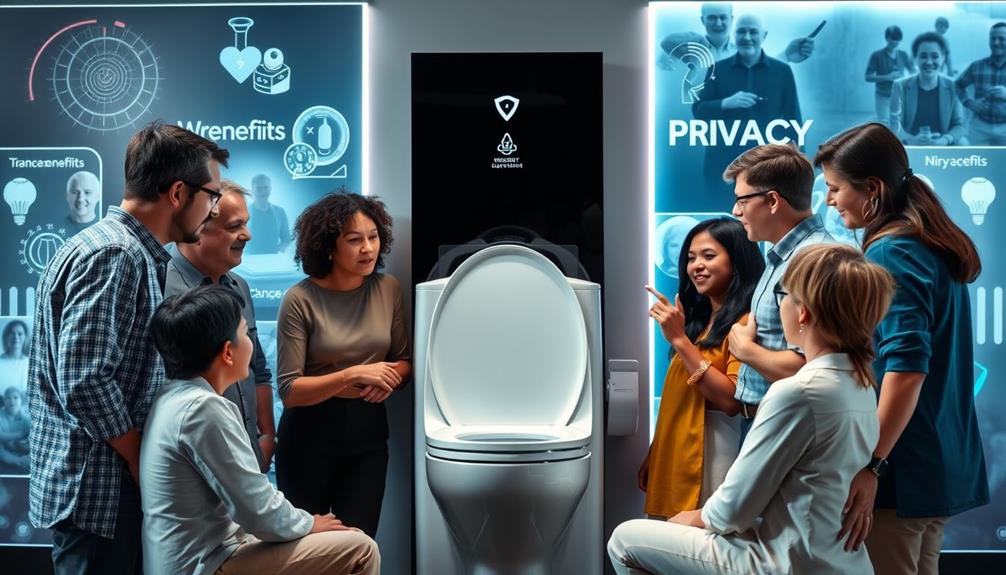
The study included 31 participants from 30 households, ensuring a diverse mix across various age groups. By targeting individuals aged 16 and older, the research aimed to capture a wide array of experiences with the smart toilet seat. Participants were strategically recruited from local newspapers, web-based news sites, and social media platforms in Gelderland, Netherlands.
This diverse demographic approach reflects the importance of understanding health management across different life stages, similar to how a holistic lifestyle approach enhances overall well-being during menopause.
However, certain exclusions were necessary to prioritize safety. The following groups weren't included in the study:
- Individuals weighing over 100 kg
- Pregnant women
- Pacemaker users
These exclusions were made to mitigate any health risks associated with the smart toilet technology. The study sought to create a representative sample across four age brackets: 16-30, 31-45, 46-65, and over 65.
This approach aimed for qualitative saturation, where a sample size of 30-40 households would reveal an extensive range of user experiences. Ultimately, the focus was on understanding how smart toilet data collection can promote health benefits while considering safety and inclusivity in the participant demographics.
Ethical Considerations in Research

What safeguards are in place to guarantee ethical integrity in research? In studies like those involving smart toilets, ethical considerations are essential. First, the researchers obtained full written consent from all participants, ensuring that individuals were fully informed about the data collection process. This step underscores the importance of informed consent in handling personal data, similar to how dog health and care emphasizes the well-being of canines through informed choices by their owners.
Before the study began, a thorough risk assessment identified no unacceptable risks, demonstrating the researchers' commitment to participant safety. Additionally, data anonymization was implemented to protect identities, aligning with core ethical principles of safeguarding sensitive health information.
Throughout the research, reflexivity was practiced, which means the team actively acknowledged their potential biases, encouraging a more objective approach. This awareness is vital in maintaining ethical integrity in research outcomes.
Moreover, the continuous modification of coding schemes during thematic analysis allowed researchers to accurately reflect emerging themes and participant perspectives. This adaptability highlights an ethical commitment to representing participants' experiences faithfully.
Altogether, these safeguards illustrate a strong framework for ethical considerations in research, ensuring that participant rights and safety remain a priority.
Expert Opinions on Smart Toilets
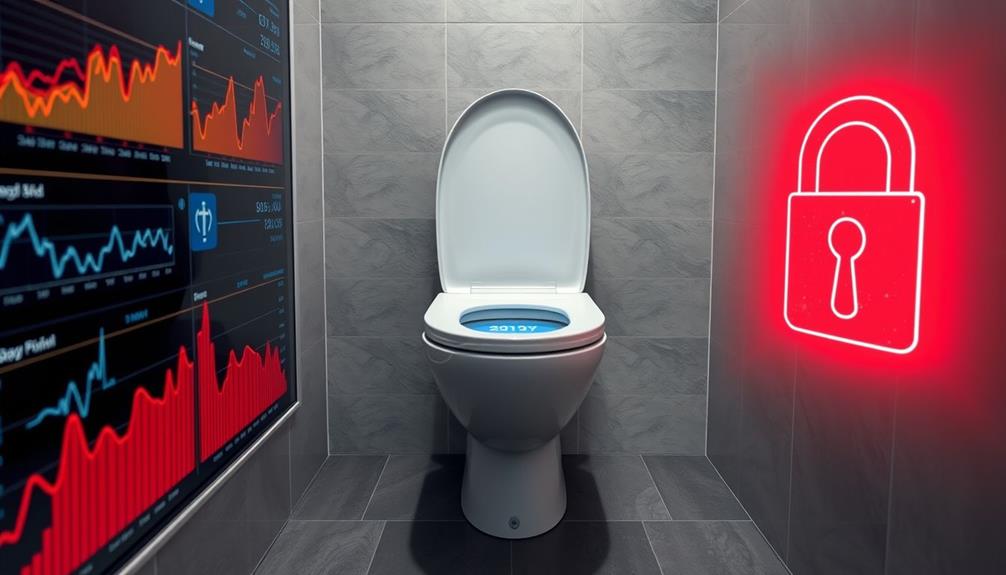
Experts frequently engage in heated discussions about smart toilets, highlighting a spectrum of opinions on their ethical implications. Some, like Renée Remijnse, strongly oppose using facial recognition technology in bathrooms, arguing it infringes on personal privacy and comfort.
Angelika Koppe echoes these concerns, questioning the necessity of invasive health-monitoring data collection. However, others, such as Diversey, advocate for visitor tracking in public bathrooms, suggesting that the operational benefits may outweigh privacy concerns.
The debate often centers around these key emotional points:
- Invasion of Privacy: Many fear the loss of personal space and comfort in such an intimate setting.
- Data Misuse: There's a growing anxiety about how collected data might be exploited or mishandled.
- Health Benefits: Proponents emphasize the potential for smart toilets to contribute considerably to medical research and public health.
As discussions unfold, experts remain divided on the ethics of advanced bathroom technology. Some call for stricter regulations to safeguard user data, while others emphasize the critical health advantages that smart toilets can provide.
Balancing these concerns is essential for the future of smart toilet implementation.
Future Trends in Smart Bathroom Tech
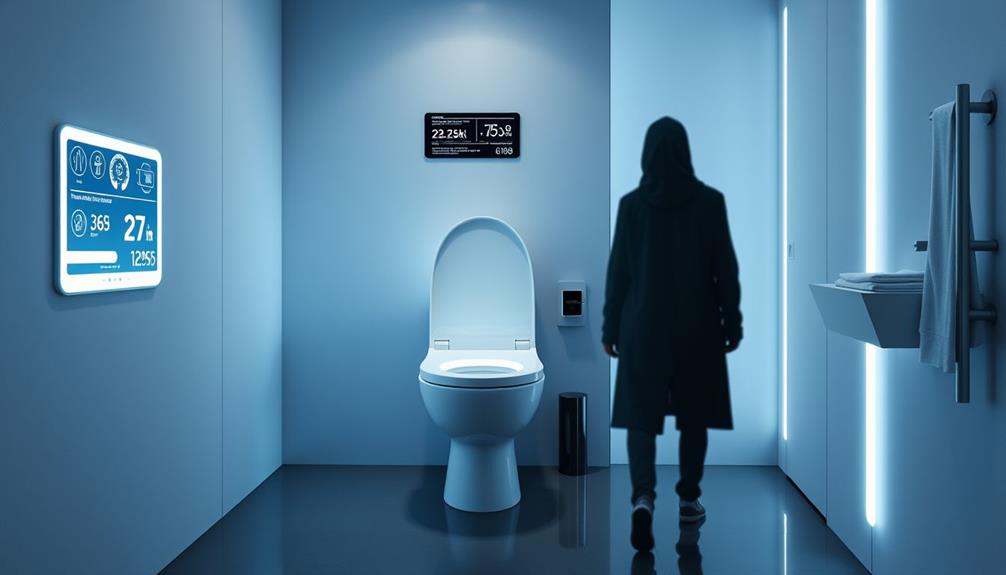
As debates about privacy and ethics continue, the future of smart bathroom technology looks promising and innovative. Imagine a world where public restrooms incorporate health monitoring systems that provide real-time data for entire populations. This evolution in smart bathroom technology is more than just convenience; it could enhance hygiene and sanitation by detecting health issues through waste analysis.
Here's a glimpse into future trends:
| Feature | Benefit | Privacy Concern |
|---|---|---|
| Health Monitoring Systems | Real-time health data collection | User consent and data security |
| Advanced Waste Analysis | Early detection of health issues | Data sharing policies |
| User-Friendly Smart Toilets | Accessible for everyone | Anonymity in data collection |
| Cost-Effective Technologies | Affordable health monitoring | Transparency in usage |
Research is also focusing on making these smart toilets cost-effective and user-friendly, with advancements in portable mass spectrometry. As cities aim to integrate smart bathroom technology into their infrastructures, the potential for improved public health outcomes becomes increasingly clear. Balancing these benefits with privacy will be essential as we move forward.
Frequently Asked Questions
What Are the Cons of Smart Toilets?
Smart toilets can invade your privacy by collecting sensitive data, potentially leading to unauthorized access. You might feel uncomfortable with their use, fearing that personal health information could be misused or shared without your consent.
How Smart Toilets Can Monitor Health?
Smart toilets monitor your health by analyzing urine for metabolites, detecting changes in flow, and identifying biomarkers. This technology provides real-time insights into your nutritional status and potential health issues, enabling proactive health management.
Are Smart Toilets Worth It?
Smart toilets can be worth it for you if you're interested in proactive health monitoring. They offer valuable insights into your metabolic health, making it easier to track changes and address potential health issues early.
Is There a Smart Toilet That Identifies Analprints?
Currently, there isn't a smart toilet specifically designed to identify analprints. While the technology is theoretically possible, it's still in development, focusing more on health monitoring rather than biometric identification, ensuring user privacy remains a priority.
Conclusion
As the debate over smart toilet data collection heats up, it's crucial to weigh the pros and cons carefully. While these innovations can enhance your health monitoring, they also raise significant privacy concerns. It's vital to find a balance that keeps your personal information safe while reaping the benefits of technology. Ultimately, staying informed and vigilant will help you navigate this evolving landscape, ensuring you don't throw the baby out with the bathwater.
With an impeccable eye for detail and a passion for bathroom-related, Ava leads our editorial team gracefully and precisely.
Under her guidance, Best Modern Toilet has flourished as the go-to resource for modern bathroom enthusiasts. In her free time, you might find Ava exploring antique shops and looking for vintage bathroom fixtures to add to her collection.
-

 Bathtub2 months ago
Bathtub2 months agoAre Clorox Toilet Wand Refills Septic Safe
-

 Reviews3 months ago
Reviews3 months agoLoupusuo Luxury Smart Toilet Review [2024]
-

 Reviews3 months ago
Reviews3 months agoSimple Project Modern Smart Toilet Review [2024]
-

 FAQ - Advanced Bathroom Queries2 months ago
FAQ - Advanced Bathroom Queries2 months agoWhat to Do if You Accidentally Flush a Paper Towel
-

 Toilet Brands2 months ago
Toilet Brands2 months agoCan You Put Toilet Paper Down the Toilet in Cyprus
-

 Reviews3 months ago
Reviews3 months agoLDian Smart Toilet Review: Luxury and Hygiene Combined [2024]
-

 Reviews2 months ago
Reviews2 months agoWhich Is Better Flush Valve or Flush Tank
-

 FAQ - Advanced Bathroom Queries2 months ago
FAQ - Advanced Bathroom Queries2 months agoWhat to Do if a Toilet Paper Roll Gets Flushed Down the Toilet






















